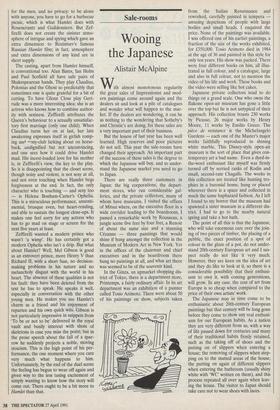Sale-rooms
Wooing the Japanese
Alistair McAlpine
With almost monotonous regularity the great sales of Impressionist and mod- ern paintings come around again and the dealers sit and look at a pile of catalogues and wonder what will happen to the mar- ket. If the dealers are wondering, it can be as nothing to the wondering that Sotheby's and Christie's are doing, for these sales are a very important part of their business.
But the lesson of last year has been well learned. High reserves and poor pictures do not sell. This year the sale-rooms have changed their approach. An important part of the success of these sales is the degree to which the Japanese will buy, and to under- stand the Japanese market you need to go to Japan.
There are really three customers in Japan: the big corporations, the depart- ment stores, who run considerable gal- leries, and the private collectors, many of whom have museums. I visited the offices of Mitsui where, on the executive floor in a wide corridor leading to the boardroom, I passed a remarkable work by Rousseau, a jungle scene five feet by four feet, a Renoir of about the same size and a stunning Cezanne — three paintings that would shine if hung amongst the collection in the Museum of Modern Art in New York. Yet in the offices of the chairman and chief executives and in the boardroom there hung no paintings at all, and what art there was seemed to be of the souvenir kind.
In the Ginza, an upmarket shopping dis- trict of Tokyo, there is a department store, Printemps, a fairly ordinary affair. In its art department was an exhibition of a painter called Tosio Arimoto. There were about 50 of his paintings on show, subjects taken from the Italian Renaissance and reworked, carefully painted in tempera amusing depictions of people with large bodies and small heads. I enquired the price. None of the paintings was available. I was offered one of his earlier paintings, a fraction of the size of the works exhibited, for £350,000. Tosio Arimoto died in 1984 at the age of 36 and painted in this style for only ten years. His show was packed. There were four different books on him, all illus- trated in full colour, and a catalogue, large and also in full colour, not to mention the video of his life and work. These books and the video were selling like hot cakes.
Japanese private collectors tend to do things on a grand scale. One who owns the Ilakone open-air museum has gone a little over the top but he is not untypical of their approach. His collection boasts 230 works by Picasso, 26 major works by Henry Moore, 11 works by Emilio Greco. The piece de resistance is the Michelangelo Gardens — each one of the Master's major works faithfully reproduced in shining white marble. This Disney-style open-air museum is the sort of place that gives con- temporary art a bad name. Even a dyed-in- the-wool enthusiast like myself was firmly turned off by serried ranks of Rodin and small, second-rate Chagalls. The works in this collection are treated like hunting tro- phies in a baronial home, hung or placed wherever there is a space and collected in much the same haphazard fashion. As I left I found to my horror that the museum had spawned a sister museum in a different dis- trict. I had to go to the nearby natural spring and take a hot bath.
The point of all this is that the Japanese, who will take enormous care over the join- ing of two pieces of timber, the placing of a pebble, the exact position of a spot of colour in the glaze of a pot, do not under- stand 20th-century European art and I sus- pect really do not like it very much. However, they are keen on the idea of art and they do like to look at it, so there is a considerable possibility that their enthusi- asm to own it, with coming generations, will grow. In any case, the cost of art from Europe is so cheap when compared to the price of their own artists' work.
The Japanese may in time come to be enthusiastic about 20th-century European paintings but that century will be long gone before they come to show any real enthusi- asm for our European habits., As a nation they are very different from us, with a way of life passed down for centuries and many of their traditional habits firmly retained, such as the taking off of shoes and the putting on of slippers when entering a house; the removing of slippers when step- ping on to the matted areas of the house; the putting on again of different slippers when entering the bathroom (usually shiny white with 'WC' written on them), and this process repeated all over again when leav- ing the house. The visitor to Japan should take care not to wear shoes with laces.


















































 Previous page
Previous page